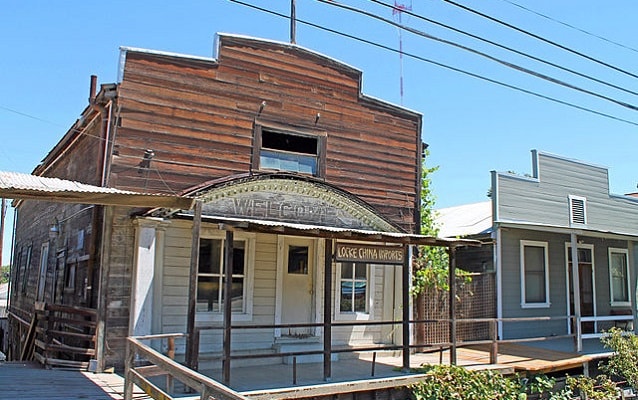Last updated: June 1, 2018
Place
Locke Historic-District, CA

Photo by Sarah Stierch, CC BY 4.0, https://commons.wikimedia.org/w/index.php?curid=21038561
The Locke Historic District, also known as the town of Locke, California, was built in 1915 by Chinese immigrants from Heungshan [Xiangshan] County (modern day Zhongshan), in Guangdong Province, China. The historic district is located in the Sacramento-San Joaquin delta, a large agricultural area in Sacramento County, California. The Locke Historic District is the largest, most complete example of a rural, agricultural Chinese American community in the United States.
Before the 1800s, immigration from Asia to the U.S. was minimal. During the 19th century, however, the U.S. experienced mass migrations of immigrants from several Asian countries, particularly China. Multiple factors triggered this large-scale immigration. In 1848, gold was discovered in California and throughout the 1850s Chinese were recruited as a major source of labor for the gold mines. Many Chinese also immigrated during this period to escape the Taiping Rebellion, a civil war that encompassed most of Southern China. In the 1860s, Chinese were recruited in large numbers from both China and the U.S. western mining industry to help build the Central Pacific Railroad's portion of the Transcontinental Railroad.
When the railroad was completed in 1869, thousands of Chinese laborers, primarily from Guangdong Province, were hired to work on an extensive levee project in California's Sacramento-San Joaquin River Delta. Their knowledge of how to develop farmland in river valleys, learned from farming the Pearl River Delta region in southern China, was used to construct a large network of earthen levees that eventually turned 500,000 acres of swamp into some of California's most valuable farm land. The reclaimed land was able to support large farms, and the expansion of the pear and asparagus industries, along with other crops, created a demand for cheap manual labor. Many of the Chinese workers stayed in the area and made a living as farm workers and sharecroppers, settling in towns in the region such as Walnut Grove, Isleton, Rio Vista, and Courtland.
The town of Locke was founded in 1915, after a fire destroyed the Chinese community in Walnut Grove. While many of the Chinese residents chose to stay and rebuild, several Chinese businessmen who had originally come from Heungshan County decided to start a new community one mile to the north. They were able to secure a verbal lease for roughly nine acres of land from George Locke, who owned an area known as Lockeport along the Sacramento River levee. Because California's Alien Land Law of 1913 prevented non-US citizens (aliens) from owning land, the lease provided ownership of any buildings, but not of the land itself, which remained with George Locke and his family.
Locke was the last of the Sacramento River Chinatowns to be built and became a thriving Chinese community serving the area's workforce, which consisted mainly of Chinese laborers working in the asparagus fields. The town eventually grew to 14 acres, and consisted of plain one and two-story wooden buildings. Besides numerous houses, Locke had a church, a small Chinese school, restaurants and boarding houses, a post office, hotels and rooming houses, a lodge, a theater, grocery stores, a hardware and herb store, a fish market, two dry goods stores, a dentist's office, a shoe repair, a bakery, and a community vegetable garden. With no police to regulate the town, bars, gambling houses, and opium dens quickly developed, operating behind commercial storefronts. By 1920, Locke was a popular location for Prohibition-era speakeasies and was providing recreational facilities to both the agricultural workforce and Caucasians from nearby cities. The town population averaged about 600 people, but on weekends and during the agricultural growing season it rose to 1,500.
Locke began a slow decline in the 1930s during the Great Depression. The end of Prohibition in 1933 and the decline of the asparagus industry meant that fewer people came to the town. In addition, increased mechanization in the agricultural industry began to reduce the need for unskilled farm labor. Locke, like many communities in the Delta, saw an increase in prosperity during World War II, but after the war many of the younger second-generation Chinese Americans began to leave the town for the cities, in search of better economic opportunities.
In 1977, the Locke family sold the town to a development company from Hong Kong. California's Alien Land Laws had been ruled unconstitutional in 1952; however, the residents of Locke never purchased the land upon which their town was built. The remaining residents continued to lease the land while numerous efforts were made to develop the area. In 1990, Locke was designated a National Historic Landmark, and in 2002, the town was sold to the Sacramento Housing and Redevelopment Agency. Working with the California State Historic Preservation Office, The Locke Foundation and the residents of the town of Locke, Sacramento County continue to preserve the many original buildings in the historic district.
Locke Historic District, a National Historic Landmark, is located in Locke, CA, 30 miles south of the city of Sacramento, CA. For more information, visit the Locke Foundation website.
Locke Historic District is the subject of an online lesson plan, Locke and Walnut Grove: Havens An Early Asian Immigrants in California. The lesson plan has been produced by the National Park Service's Teaching with Historic Places program, which offers a series of online classroom-ready lesson plans on registered historic places. To learn more, visit the Teaching with Historic Places website. Locke Historic District has been documented by the National Park Service's Historic American Buildings Survey.
